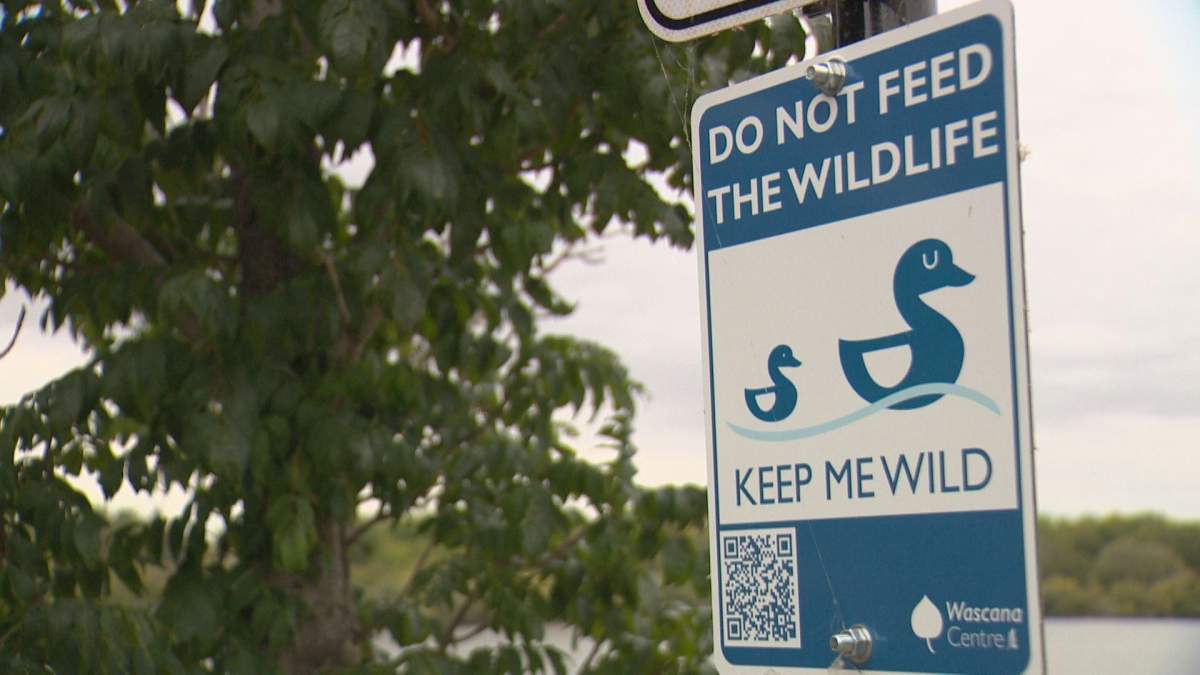Those who maintain Wascana Park in Regina are asking you to leave the grains, greens and bread at home the next time you visit the lake.

While feeding the wildlife in the park can afford an up close and personal experience with animals such as the iconic Canada goose, experts say it can also come with consequences.
“Feeding wildlife can lead to a loss of fear of humans, so in this case we have a lot of geese in the park that will come and kind of crash your picnic,” said Provincial Capital Commission ecologist Sarah Romuld.
“They can develop rather aggressive behaviour. And you have congregating wildlife in some areas which can lead to transfer of disease .”
Romuld says feeding wildlife can also cause problems such as the introduction of invasive/noxious/undesirable vegetation from uneaten grains and seeds. She said instances of angelwing have also been detected, which can render young waterfowl flightless.
That’s why Wascana Centre, a branch of the PCC, has launched phase two of its “No Feeding Initiative”, which includes newly-installed signs visitors to the park will see posted in high-traffic areas.

Get breaking National news
Back in 2015, the Wascana Centre launched “Bread is Bad For Me”, phase one of the initiative.
That campaign encouraged park visitors to leave the bread at home and instead bring grains or greens if they wanted to feed wildlife.
Phase two of the initiative now asks park patrons to stop feeding wildlife entirely.
“Now we’re trying to communicate, okay we’ve made that shift, but we actually don’t need to feed wildlife at all,” said Romuld.
“We are in a natural area, and there’s lots of resources for them to naturally forage on. So we’re just trying to make that final shift to not feeding at all.”
PCC Forestry and Horticulture Manager Lisa Esmond reminded visitors that the prairie park is a product of generations of dedicated work, and that the efforts of all are required to keep it as wild as possible.
“This is a handplanted, beautiful masterpiece. Previously, before the park, this was just farmland,” she said.
Romuld adds there’s another benefit of leaving your goose food at home which is, perhaps for many who frequent the park, the easiest of all to identify with.
“They’re not congregating in those high traffic areas, so they’re not eating in excess, and as a result, there’s less excrement.”
While the number of humans frequenting the park may be dwindling as cooler weather arrives, the number of Canada geese will stay high.
As many as 10,000 geese use Wascana Centre as a migratory rest stop each fall en route to warmer climes like South Dakota, Nebraska and Kansas.
For the best birdwatching experience, Romuld suggests coming to the park in the morning and bringing binoculars, and adds that birds can still be seen through the winter on parts of the lake close to aerators, such as near Pine Island, where the water does not typically freeze over.










Comments